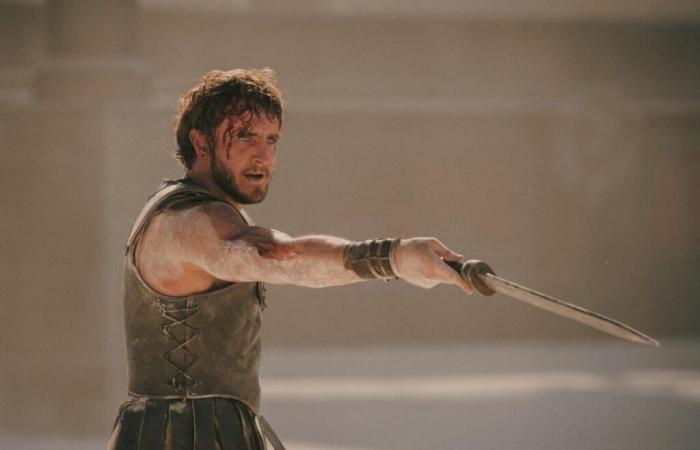Warning, this article contains spoilers!
In good blockbuster that he is, Gladiator 2 is far, very far, from offering a fine cinematographic reconstruction of one of the most sulfurous and fantasized parts of the history of the Roman Empire: the gladiator. But who is surprised? And above all, who cares?
Yes, the film uses and abuses shortcuts, anachronisms and exaggerations of all kinds, particularly when it comes to throwing ferocious beasts stuffed with virtual steroids into the arena. But after all, its primary mission is to provide its audience with a great show. Nevertheless, Gladiator 2 sometimes depicts with a certain realism a period which, according to historian Éric Teyssier, is too rare in cinema (the plot takes place around the year 211, approximately twenty years after that of the first part). For Science and Futurethe author of Gladiators (published on October 30, 2024 by Glénat), who was able to see the film before its release, disentangles the truth from the falsehood.
Sciences et Avenir: Personally, what did you think of the film, eagerly awaited by the many spectators who loved the first Gladiator ?
Eric Teyssier: I must already tell you that I am one of these spectators, not to say absolute fans of Gladiator. This film even changed my life because at the time of its release, in 2000, I was a lecturer in history on a completely different subject: the economic and social history of the French Revolution and the Empire. I loved the film so much that I got into re-enactment archaeology, which is an experimental discipline applied to gladiators.
I then ended up devoting my state thesis to these same gladiators with a view to obtaining my Habilitation to Direct Research (HDR, the highest level of qualification in the French university system, editor's note). So it’s an understatement to say that I was waiting for this sequel.
Unfortunately, it didn't thrill me as much, firstly because there was no longer the element of surprise from the first time. And there is no longer the exceptional Russell Crowe, even if the actors are good. I still had a good time because the film remains for me good entertainment which allows us to talk about history and especially about a period that we see too little in the cinema.
“A naval battle really took place at the Colosseum during its inauguration”
Ignoring, of course, the film's historical aberrations specific to the Hollywood style, did any of its aspects strike you with its realism?
Well in the same way that the quality of the soldiers' and legionnaires' costumes struck me in Napoleon last year (also by Ridley Scott and to whom we devoted an article, editor's note), I found that the costumes were very well made in Gladiator 2. If we put aside the fact that the general played by Pedro Pascal fights without a helmet and without a shield, which is completely absurd… But yes, generally speaking, the warrior equipment is very good reconstituted.
To be honest, I had the feeling that from the point of view of its historical relevance – and here again, I remind you that this is not what we necessarily expect from this film -, Gladiator 2 does things a bit by halves. Consider the scene of the naval battle at the Colosseum in Rome. These kinds of water show fights actually existed in the world of Roman entertainment, and in fact, a naval battle actually took place at the Colosseum when it was inaugurated by Titus in 80 CE.
The arena had been filled with water via the city's highly developed aqueduct system. But this could only happen this time because then the basement spaces dedicated to stage effects were developed. So why not this scene, but why use sharks? It's stupid and a shame. They could have added crocodiles, at the limit…
Read alsoDachshund bones and remains of “snacks” found in the sewers of the Colosseum in Rome
How is the film about gladiators?
In fact, it mixes two eras of gladiature. A first which lasted until the greatest slave uprising that the Roman Republic had known, between 73 and 71 BC, and of which the gladiator of Thracian origin Spartacus was at the origin. During this first period, the vast majority of gladiators were prisoners of war forced to fight in the arena. Moreover, there are so many of these prisoners that gladiator shows are a very profitable way of getting rid of them, of “destocking” as I say.
This sad condition will therefore be one of the reasons for the slave revolt of 73, and the emperor will realize that it is dangerous to keep thousands of men locked up with the prospect that they will kill each other for pleasure. of the people.
HAS From there, gladiatorship will evolve. Gladiators are no longer prisoners and slaves but paid volunteers, the most successful – and the most famous – of whom are sometimes paid very dearly. They are hired, with supporting contracts, by lanistes, or trainer in Latin, who are roughly merchants and owners of a troop of gladiators called a gladiatorial family.
They all train together, supervised by a “doctor” (doctors), term used to designate coaches. During these sessions, their weapons are fake because there is no question of being injured. The goal is to push their technical skills to the maximum and win fights just like boxers do today. The film is therefore a mixture of these two parts of the gladiatorial story.
Lucius is promised that he can regain his freedom by winning victories in the arena. Was this really a way for the forced gladiators to become free men again?
Unfortunately, we have less information on the period of forced gladiatorship, which I also call “ethnic”, than on the second. What we know is that the gladiators were shown there in their original equipment, that is to say in the combat outfit of the people to which they belonged. We thus found in the arena Samnites, Gauls, Thracians and even Germans, with all their paraphernalia. We also know that gladiator trainers also existed at this time, and that they had undoubtedly been talented gladiators themselves in the past.
In short, their lives had been preserved so that they could pass on their techniques to other slaves. So if they could not emerge truly free from this condition, they could at least emerge alive. You know, the Romans were not looking for blood and death at all costs. Above all, they wanted to admire the technical gesture, the bravery and the courage. Hence the presence of coaches.
Read alsoDiscovery in Pompeii of the tomb of a rich patron who organized gladiator fights
“There were many human/animal spectacles (…): those of those condemned to death thrown to the animals”
How did you end up performing in front of the emperor at the Colosseum in Rome?
By having the best possible record, quite simply. We will rarely put in the arena a gladiator who is starting his career against someone who already has 15 victories to his credit. The emperor had his own champions who fought against other lanist champions and sometimes things went wrong… Caligula for example was very angry when his foal was defeated by another, to the point that he poisoned the winner.
But other emperors played the game, let's say they had “sportsmanship”. Vespasian, in particular, followed the people and often ended up supporting the one for whom the public was enthusiastic. This is a bit like what the phrase “bread and circuses” means. HAS a moment of the Empire during which democracy is no longer, there is only during shows that the people can express themselves.
In the film we see rabid baboons and rhinoceroses fighting in the arena. Were these animals really used?
Baboons this mad don't exist, right? (Laughs). Here again, the film mixes things up. There were professionals who fought against animals, often wild animals. But gladiators fought between men. These two professions never mixed. On the other hand, there were many human/animal spectacles, the cruelest: those of those condemned to death thrown to the animals.
Regarding the fauna that may have ended up in the amphitheaters, it was a bit nonsense. HAS Rome, the emperor had the means to bring in just about anything he wanted, that is, lions, tigers and sometimes, yes, rhinoceroses. We know in particular that a rhinoceros was one day attached to a wild bull to provoke their inevitable – and very sad – fight… In the provinces, less expensive animals such as bulls or bears were instead brought into the arenas. But just as capable of killing men.
Finally, let's talk a little about the brother emperors, Geta and Caracalla…
Once again, what we see of them is half true. These brothers only governed together for a few months, probably at a distance from each other. Upon his death in 211 CE, Septimius Severus, their father, expressed the wish that his two sons would succeed him and rule together. Which, of course, was not viable, especially since Geta and Caracalla had never had the complicity that the film attributes to them.
They had always hated each other. Besides, they were terrified of being poisoned by one or the other. Caracalla, who was a real thick brute, ended up stabbing his brother in their mother's arms. To be sure, Caracalla's angry and cruel temperament is not exaggerated in the film. Geta was more gentle and level-headed.
We still want to ask the question: what do you think is the greatest historical inconsistency in the film?
Without hesitation, the fact that a lanist could seize power. This would have been simply impossible during the time of the Empire. Lanists are men with a troubled aura. They trade in blood and repel society in the same way that butchers and undertakers can be repulsed today, in certain aspects. Paradoxically, they are also admired as artists or great sportsmen. In any case, they have nothing to do with power.






